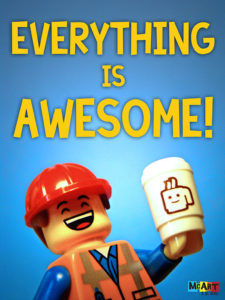I’ve made no secret about my lack of organizational skills. I often made a joke about Neil Gaiman’s assertion that clients want 3 things: people they like, great work, and on-time work. And they’ll be happy with 2 out of 3. For quite some time, I was doing very well producing great work for clients who loved me. Deadlines were another story.
Enter KC.
KC challenged my belief that 2 outta 3 ain’t bad and made me strive for great, on-time work while still being my lovable self. He recognized a need in my business and helped me to fill it.
Well, we’re going on a year as KC working as my full-time project manager. In that year, I’ve grown my revenue so much that my payment processor was put on alert (long story for another day). Prospective clients are never ignored or forgotten and just this month I’ve been able to deliver multiple projects a week earlier than projected.
So how does he do it?
I asked him to write up in his own words what he thought were the key changes made in the business in the last 12 months. So, I’m excited to introduce my first ever “guest author.” Take it away, KC:
The Greatest Challenge
I’ve fought against terrorists and drug gangs…
Protected cabinet-level dignitaries and ministers on 6 continents…
With all that (and more) my greatest challenge has come in the last year-ish!
You might ask, “Are you off traipsing around war-torn countries again… facing off against society’s seedy underbelly again?”
Nope!
I work every day trying to keep a “creative” on task and focussed!
Scary thought, right?
Over a year ago I made a dramatic shift in my goals. I had the tremendous fortune to meet and begin working for (and living with) a copywriter.
She found her business growing at such a rate she could no longer keep track of all the deliverables, keep the finances straight, and ensure her clients were happy — all while trying to continue the growth of her passion and business.
She writes amazing stuff — can encourage even the most reluctant customers to go all-in on a product or offering. Identify the pain points and address and overcome objections through a solid understanding of behavioral psychology. But keep a simple (yet rapidly more complex) schedule? This was beyond her.
Enter the systems-minded, process oriented project manager. That’s me!
Quick story time… I can recall a late night early on when a hard deadline was looming. And there she was sitting at the dining room table — sweatshirt hood pulled over her head — wearing a puss and whacking away at her keyboard trying to finish the copy. Not only was it impossible in this situation for her to produce the very best product, but she wouldn’t enjoy the writing — at all.
If a creative doesn’t enjoy what they’re creating… well, it will probably come out lousy to say the least.
My goal was to never again have that happen.
First things first… Build the back-end systems that support and prop up the front.
Was it feasible at the time to prepare one-off quotes, proposals, contracts and invoices for each new project? Track the projects to ensure timely client delivery? Perhaps, but only for a very short time. Indeed, that would prove unmanageable pretty quickly as her client list multiplied — and international clients came into the fold.
So, I spend the first couple of months building out the processes and systems to automate these pieces. By creating systematic (and intuitive) workflows we could ensure that no client inquiries went unaddressed, and of course that no deadlines or benchmarks were missed. This allowed her to stop trying to keep her head above water, and to grow her business.
What I learned pretty quickly was to…
Find that balance (the elusive sweet spot) between too much structure and just the right amount.
Working with a creative has been both enlightening, and at times, supremely frustrating.
What may seem painfully obvious to a systems minded person can prove mysterious to the creative mind.
Our everyday communications are surely enhanced by how we compliment each other’s strengths and weaknesses. But, to be truly successful at this thing we needed to create the simple systems to make complex challenges and difficult client demands easy to overcome.
Creating workflows that trigger certain actions to happen during an otherwise convoluted process is the key. But also learning how — and when — to apply the right amount of pressure. Too much and they shut down. Too little and you lose clients by blowing deliverable deadlines.
Here are just a few of the systems we created:
- Automated scheduling. Clients and prospects can set up a call, and the time is blocked in our project tracker and calendar. Just as important is the fact that time set aside for client work is not available on the scheduler. NEVER double-book a creative! It usually results in their head spontaneously combusting.
- Project workflows. This is where it all starts! Spend the time here to build the systems that automate and track projects from the initial client call through final product delivery to the customer out-boarding questionnaire (and every step in between).
- Portfolio database. Often, prospective clients will ask for samples. We now have an organized document that can be tweaked for each project so every client gets the most relevant sample for their niche or product type.
- Contract and proposal templates that allow us to answer client inquiries in a much more timely manner. These include a standard pricing structure, answers to common “process” questions, and legal terms that protect everyone. And, we don’t have to reinvent the wheel with every new job. Beware: having templates is great, but should only be used as a framework to communicate with clients — never let client’s feel like they are getting a canned, cookie-cutter response, regardless of the simplicity of their questions. The customer experience must never be overlooked (channeling my friend Joey Coleman)!
By standing up these systems, we have freed up tremendous time that we could use to help our clients meet their goals.
One other item of note here, and one that has been instrumental in our growth and success:
Stop Working From Home!
It is no exaggeration to say that we were able to 5x our productivity by setting up in a suitable office space. This can be easier (and cheaper) than you think. Find a co-working space. Even our little town of Oneida, NY has one. (check out our amazing space here!)
These spaces are fantastic. Not only does it draw a clean delineation between work time and home time, it opens up the opportunity to interact with other entrepreneurs — and even explore new ideas together.
Even if you have a quiet house with no kids — which we most certainly do not — there are just too many distractions at your home. Things like: “Hmm, I should take care of that laundry that is piling up…” or “That show that I really like is about to come on…” or (insert other common distraction-at-my-house here).
However, if you find your community woefully lacking in any type of co-working space, all is not lost. You can set yourself up to work efficiently from your home. But, you must set up a separate room just for that task and have the discipline to not allow one zone to overlap the other. No dining room tables like where we started out 🙂
The Results and the Bottom Line…
Fast forward to today. We are consistently hitting our profit goals. She has clients around the world (love our Australian folks!). Clients are seeking her out for her amazing copy.

Spend the time to develop the systems. 100 hours in effective systems development can easily become 1000’s of hours in saved time (and late night frustration).
Then, trust the systems you create, but be flexible enough to tweak them when you identify shortcomings or scalability issues.
-KC
P.S. There are loads of books out there about this topic. One of my favorites is Sam Carpenter’s Work the System: The simple mechanics of making more and working less


Literally the exact position I’m in right now, KC. Thanks for sharing the process of everything behind the scenes!
Would love to learn more about the processes if they’re available. Where can I find it?
And Abbey, rockstar content. =)
**Would love to learn more about YOU. Haha, sent that too early. Where can I find out more about you (and your processes)
Not sure what the date is on this blog, however, I am also a creative entrepeneur and STRUGGLE with organization and systems. I know the need and it is frustrating for me that I just cannot think that way.
Looking forward to more on this topic. How do I stay connected?
Hey Tim! Glad you enjoyed the piece. Because of the response we got to this piece, in the next few weeks we are going to develop some more posts and possibly even a guide to the exact systems (including inexpensive and free software) that we use. Keep an eye out!
On a side note, this piece has been one of my most popular. We were surprised at how many people are looking for more on this! I might make KC do more of my writing! 😛
This was definitely excellent. Count me as another one interested in more details on your system. Thank you!
🙂
Hey Abbey,
Loved the interview on CCR. “Step 13 of 17 is doing the job…” was the kicker for me.
Plus, realising how much time and effort I put in BEFORE I’m even at the proposal stage.
There are a lot of steps.
I actually teach my clients to focus on getting hired/paid first –>> Then do all the research – which is a big time component.
I am now breaking down ALL the steps in my process…
Looking forward to more info on your system and It would be great to see the graphic you mentioned. Is it on CC?
Thanks Lawrence! You can get the workflow graphic here: http://www.onlifeandwriting.com/copywritingworkflow
Lots more to come!